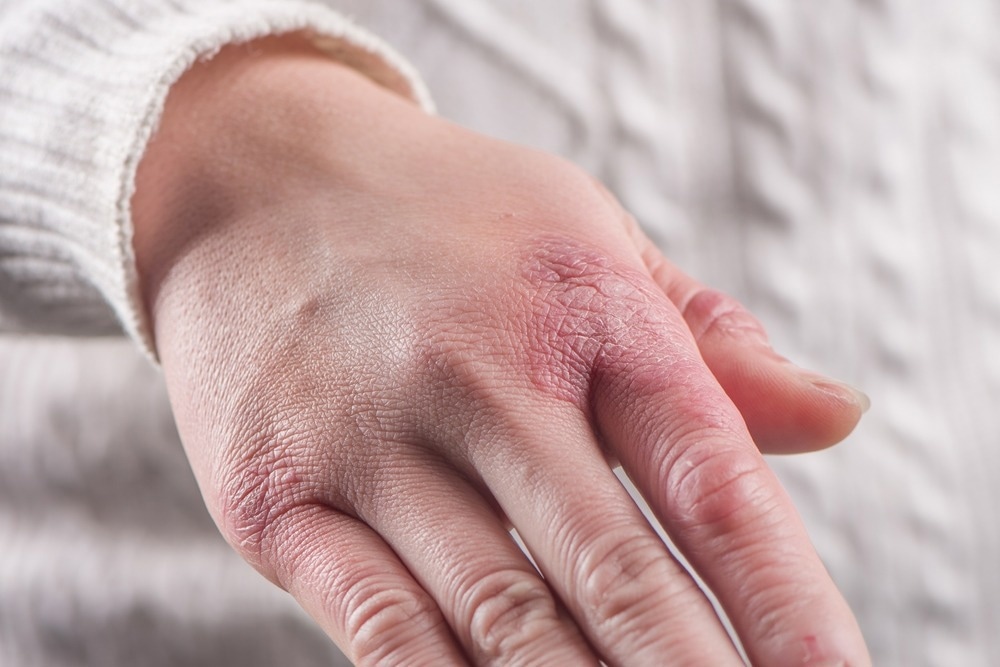A recent study published in the British Journal of Dermatology evaluated coronavirus disease 2019 (COVID-19)-associated chilblains (CACs).
 Study: COVID-19 pandemic associated chilblains. More link for SARS-CoV-2 and less evidence for high interferon type-1 systemic response. Image Credit: kungfu01/Shutterstock
Study: COVID-19 pandemic associated chilblains. More link for SARS-CoV-2 and less evidence for high interferon type-1 systemic response. Image Credit: kungfu01/Shutterstock
Background
Since the onset of the COVID-19 pandemic, the direct role of SARS-CoV-2 in CACs has been widely debated due to the low positivity rate of SARS-CoV-2 reverse-transcription polymerase chain reaction (RT-PCR) and serologic tests. However, the suspected pathogenic role of type I interferons (IFNs) is indirectly supported by the in situ immune responses analyses.
The study and findings
In the present study, researchers assessed adults and children with a new diagnosis of CAC seen in infectious diseases, dermatology, pediatric, and adult emergency departments at the University Hospital of Montpellier. Fifty outpatients were seen at the hospital, mostly Caucasians and females. The median age was 21, with a median body mass index (BMI) of 19.8.
CAC was noted in the hands of 66.1% of patients and the feet of 85.5%. Bier anemic spots, cyanosis, urticaria-like eruption (BASCULE) syndrome, subungual splinter hemorrhages, and Raynaud syndrome were present in 13.3%, 8.3%, and 17.7% of patients, respectively. 93.3% of patients recovered (from CAC) completely; CAC persistence was noted in 6.7% of patients, and CAC recurred in 42.9%.
The authors found that SARS-CoV-2 RT-PCR results were positive for 10% of patients, while SARS-CoV-2-immunoglobulin G (IgG), IgA, or IgM serology was positive in 23% of patients. Neutralizing antibody responses were detected in one patient. Anti-nucleocapsid antibodies were detected in 13.2% of patients. Accordingly, it was established that 22% of the cohort was infected with SARS-CoV-2, including 18% of adults and 32% of children.
In a multivariate analysis, the clinical, histologic, and biologic characteristics of the patients with or without SARS-CoV-2 infection were not significantly different. Thirty patients with CAC were tested for the expression of IFN-stimulated genes (ISG), and the authors found that ISGs were upregulated in CAC patients relative to controls.
Finally, the team evaluated whether the upregulation of ISGs differed between CAC and other COVID-19 phenotypes. To this end, they analyzed the available ISG scores within 50 days of symptom onset in three cohorts: CAC with 19 subjects, severe COVID-19 (requiring intensive care) with 72 patients, and mild COVID-19 with eight (non-hospitalized) patients.
The ISG measures on day 10 of symptom onset in the CAC cohort were similar to those of acute infection. Overall, the ISG kinetics were identical to severe or mild COVID-19 patients, reaching normal levels by 20 days post-symptom onset. Two patients had anti-IFN-alpha-2 antibodies above the cut-off of 34 ng/ml.
Conclusions
In summary, the authors found that CAC characteristics such as the balanced sex ratio, clinical presentation and outcomes, and predominance of slim patients were broadly comparable to those from previous studies. The frequencies of subungual splinter hemorrhages, BASCULE syndrome, and Raynaud syndrome were significantly high, plausibly explained by the prospective nature of the research and the lack of clinical details in some large studies.
Overall, 22% of patients were virologically confirmed of SARS-CoV-2 infection, including 32% of pediatric cases, consistent with 30% to 37% of seroconversion in children with mild or asymptomatic COVID-19. Moreover, the authors observed that type I IFN signaling was elevated in CAC patients. Still, the overall ISG kinetics were similar to those of COVID-19 patients without CAC, underscoring the dynamics of systemic immune responses during SARS-CoV-2 infection.
Yet, prior studies revealed that CAC comprised a lymphocytic inflammatory response with a type I IFN microenvironment. Therefore, the authors suggested that the role of type I IFNs in CAC pathogenesis may be envisaged through local susceptibility to a physiologic type I IFN response instead of systemic ISG overexpression during COVID-19.